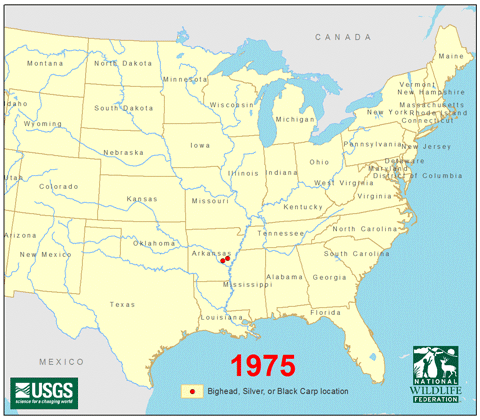
If Asian carp make it to Lake Erie, they'll make themselves right at home. (AP Photo/John Flesher, File)
A new study suggests that Asian carp, which have been spotted in watersheds close to the Great Lakes, would make themselves right at home if they made it to Lake Erie. The study, published recently in the journal Transactions of the American Fisheries Society, used computer modeling to estimate the effect these fish would have on native species.
[Uh-oh: One of the world’s worst invasive species made it to the United States]
Bighead and silver carp were first introduced to the United States in the 1970s, when they were imported to control algae growth in aquaculture and sewage treatment ponds. They escaped into the Mississippi River during floods a few years later. Like many invasive species, they've been able to out-compete local populations and have spread quickly.

The spread of the Asian carp. (National Wildlife Federation)
According to the Ohio Environmental Council, there's reason to believe that individual bighead and silver carp have already made it into Lake Erie (which has the biggest fish population of any of the Great Lakes). But for now, there isn't an active breeding population that we know of, thanks to over $300 million in efforts from federal agencies.
Conservationists know, however, that it's simply a matter of time. So they have to ask — when Asian carp start breeding in the lake, just how much damage will they do?
[This invasive fish can live for days on land, dragging itself along with its gills]
In the new study, which used food-web models, researchers found that the decrease seen in other species might not be as great as one would expect. In fact, some species might even see a population increase should foreign fish move into the neighborhood, because the carp would take care of their more direct competitors for them, and their young would provide an abundant food source for any fish-eating fish. But other species, including prized sport species like walleye and rainbow trout, would see a sharp decline.
The best way to beat an invasive species is to eat it. Asian carp have been fished for commercial sale, but most of the market is in China. While the fish are reportedly delicious, they're very bony, making for a tough filleting process and a surprisingly low yield of meat for such a large fish. In any case, they're certainly not easy substitutes for the popular sport fish that currently fill Lake Erie.
Asian carp, which grow quickly and can eat up to 20 percent of their body weight each day, could come to make up 34 percent of the total fish weight in the lake, making them the most abundant fish in terms of biomass.
“It’s very sobering,” Marc Gaden, spokesman for the Great Lakes Fishery Commission, told the Associated Press. “Lake Erie is one of the most productive inland fisheries in the world. It wouldn’t be as valuable by any stretch of the imagination if one out of every three pounds of fish were Asian carp.”
It's a staggering ecosystem shift, but it's nothing compared with what's happened in the Illinois River, where some areas are now 60 percent Asian carp. In the Illinois River, Asian carp have actually become a hazard to human health: Recreational boaters have been hit in the face by leaping fish. A startled silver carp can jump up to 10 feet out of the water, and the impact has been compared to being hit with a fast-moving bowling ball. These issues could arise in the Great Lakes as well.
"Model results suggest the most likely intensity is severe — who wants a third of the fish biomass in Lake Erie to be Asian carp? — but that possible outcomes include both stronger and weaker impacts," study co-author David Lodge of the University of Notre Dame said in a statement. "It is also important to remember that our research provides scenarios for impact only on the food web and only in Lake Erie itself. Impacts like jumping fish hitting people are not included, nor are any impacts in tributaries of Lake Erie that might suffer impacts like those in the Illinois River."
The new model incorporates input from 11 leading experts on Asian carp biology and Great Lakes ecology and fisheries, so it's a comprehensive look at the various possible outcomes. But it's still just one model, and it's possible that the reality of the inevitable invasion will be better — or worse.
The team is now working on models for the lakes Michigan, Huron and Ontario, as well as models for the economic impacts of the projected outcome in Lake Erie.
Originally published by Rachel Feltman at www.washingtonpost.com on January 4, 2016.